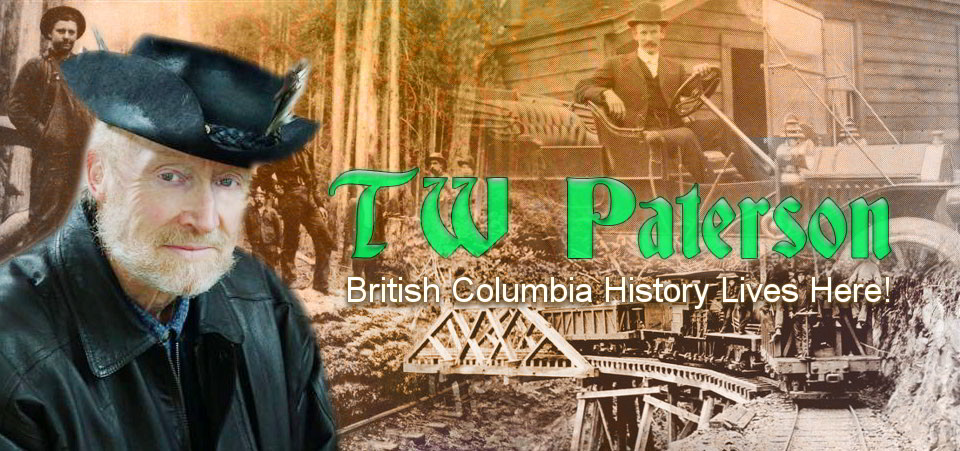JOHN KERGAN: HERMIT OF TRIAL ISLAND
Who was John Kergan?
We know no more about him today than Victorians did over a century ago: that he had been a seaman on the Great Lakes and that he was adept at boat building, inventing and painting. Some even thought him a mechanical and artistic genius.
To one and all he was the “Hermit of Trial Island.”
Whatever his past, Kergan seemed to have but one desire in life: to live by himself without interruption or the amenities of civilization. Just offshore of Victoria, on Trial Island, then uninhabited but for seabirds, seals, mink and occasional picnickers, he constructed a crude shelter of driftwood. He was almost totally self-sufficient; with a home-made forge, and rip-saw powered by a windmill of driftwood, he built boats. His salt also was provided by the sea and wild berries on the island were picked for jam, clams were smoked.
A more fascinating endeavour was his manufacture of blankets—from “sheets of fruit which I prepare by a process of my own.”
Those supplies he couldn’t produce, procure or preserve on his island, he’d buy in Victoria during infrequent visits in his home-made boat. For money, he sold his paintings to wealthy residents.
Alas, his self-imposed exile within sight of the growing capital was to be brief, his idyllic peace shattered by the inquisitiveness of citizens who just wouldn’t let him be. It was the visit of a reporter that brought matters to a head; in the ensuing glare of the public eye, Kergan found his hideaway a refuge no longer.
Ironically, posterity is indebted to the unnamed journalist who, in destroying Kergan’s peace, left us an intriguing portrait of this most unusual man who once camped on Victoria’s doorstep.
The reporter had first been struck by the recluse’s shack: “Everything about the queer hut showed that the owner is possessed of a mind not educated, but of unusual ability, especially in the mechanical line. Dozens of small articles, all evidently of home manufacture, attested to the skill of this strange being who evidently does not believe that `it is not well for a man to be alone.'”
The journalist had been accompanied on that spring day in 1893 by Sgt. Langley
of the B.C. Provincial Police. More accurately, it was the other way round, the reporter having invited himself along when he spotted the sergeant warming up a motor launch at the Outer Wharf.
Langley further whetted his appetite for a story by his refusal to disclose their destination as the “rakish little craft sped away like a young colt” from shore. Arching to the southwest, they passed the hulk of the collier San Pedro, her back broken on Brotchie Ledge, and continued on towards Trial Islands.
Passing under the lee of the main island, Langley dropped anchor and, “in a few moments, the party stood on the beach. Making toward a rough cabin, evidently built of driftwood, the party was welcomed by a strange looking man o f some 38 to 40 years. He answered the usual salutations readily, and after a moments’ conversation invited the sergeant and his companion to enter his cabin.”
Inside, they were amazed by its contents.
“Here was displayed, in a wonderful manner, the various devices whereby a man with but a few of the implements of civilization may still manage to render himself comparatively comfortable. The place and its contents reminded one forcibly of pictures which the youthful imagination is wont to form after a perusal of Defoe’s immortal `Robinson Crusoe.’
“A small sign on the door, `Look out for bulldogs,’ was the first thing explained. This was pasted over a hole containing a pistol cartridge, and, by a very ingenious system of springs, when the latch of the door is disturbed, the cartridge is discharged. The man explained that once someone had opened his cabinet and taken some things; hence the trap.”
Much to his visitors’ surprise the hermit, whose name was not released, proved to be quite garrulous and answered their questions politely and fully. Asked how he spent his time, he replied: “Well, sometimes I sit for days only thinking, thinking, but I am busy too. See here, this is good salt, is it not? Well, I make it right here. That is condensed jam, made from berries which grow on the island. It will keep like that for years.
“Those blankets rolled up are sheets of fruit which I prepare by a process of my own. I could make you a suit of clothes or a hat out of it, only you would have to keep it out of the wet. Here are some clams which I smoke and put away. This is a windmill which I made from driftwood. It runs a small saw of my own make. With this I rip up the driftwood into strips and build a boat now and then. Here is a forge, the fan of which I made, and here I burn my charcoal. I can make almost anything I need, and what I can’t make I can very well do without.”
The reporter was most impressed by the hermit’s paintings, sketches of local subjects in water colours and in oils (both paints of his own manufacture) which, he opined, “showed plainly the possession of no mean amount of skill.”
With that, the visitors left. Instead of finding a suspicious character, Langley and the newsman had encountered a unique and memorable personality; so unique, that the reporter was inspired to write a full-length feature of his visit to Trial Island, under the gushing headline:
An island hermit; a visit to one who has no use for civilization and would rather be alone; strange life of isolation!
The result of this publicity can well be imagined. In following days the happy hermit was invaded by curiosity-seekers—all forewarned against the “bulldogs” and booby-trapped latch Within days, driven from the comfortable quarters he’d hewd so painstakingly of driftwood, he vanished.
When he again claimed public attention, more than a year later, it was to make Victorians marvel all the more.
The fascinating hermit of Trial Island was dead, his splintered boat having been recovered by the Port Renfrew telegraph operator near Sombrio Head after a savage gale. It seems that the “queer character” who’d been living on a small island nearby had departed for Victoria for supplies. When he didn’t return the concerned telegrapher searched for him. He found the wreckage of his boat near Sombrio where the heavy surf precluded all possibility of his having survived.
When the steamer Mischief brought word of the mishap to town, the Colonist reporter connected Port Renfrew’s recluse with the hermit of Trial Island. His conjecture was confirmed by a pioneer resident who, identifying himself only by his initials, W.G.H.E. wrote the newspaper to tell of his acquaintanceship with the mystery man.
Today, we thank the Rev. W.G.H. Ellison for having identified the hermit he knew as John Kergan, an Irish-Canadian from eastern Canada where, “as a waterman on the lakes and rivers, he developed that fearless skill and daring for which he was well known”.
Ellison explained that he’d met Kergan off Cape Flattery when the hermit was searching for a new refuge after fleeing Trial Island. Upon choosing his new homestead, he “carried on some experiments of which his fertile brain seemed full…” He left Trial Island because he was constantly being robbed of his small possessions; he told Ellison he’d “tried to stop it by placing a cartridge over the door, intending to catch the intruder, but the man who intended to rob me evidently told the police'”.
Ellison praised Kergan for his “sterling qualities of uprightness, honesty and straight-forwardness [which] were made known to all who came across him. It is sad to think that a man who had such remarkable gifts should have been virtually lost. When the writer last saw him, he said, `Well, my natural life is now half over, and I wish to spend the remainder alone and in peace.’ Alas, it was the peace of eternity, entered upon off the stormy shore of western Vancouver Island. Perhaps to sum up this man’s character, it might be said it was simplicity and purity, `the two wings by which man is lifted above all earthly things; simplicity is intention, purity is affection, simplicity tends to God, purity apprehends and tastes Him'”.
And with that noble tribute, John Kergan, the hermit of Trial Island, was forgotten.
What of his paintings which, “drawn from nature, adorn the walls of well-to-do people’s houses in Victoria?” Where are they now? They’d be well worth having, not only for their sentimental value but for the fact that, to quote the reporter who’d defiled his Trial Island refuge, the water colours and oil canvases, “though crude, showed plainly the possession of no mean amount of skill”.
There’s a fascinating footnote, as published in the Colonist in 1894: “The body of a Trial Island hermit will likely be exhumed this week by gold seekers. Before the unfortunate man started out on the expedition that terminated in his drowning, he borrowed $50 in gold coin from a friend.
“The supposition is that when his body was found, the gold in his pocket was overlooked.”

3 Comments
Trackbacks/Pingbacks
- T.W. PATERSON – BRITISH COLUMBIA’S PIERRE BERTON | richardhughes.ca - […] JOHN KERGAN: HERMIT OF TRIAL ISLAND […]

Hello TW and Merry Christmas from Lake Cowichan.
I found this article fascinating. Thank you for unearthing this little gem. As a footnote I found this in an old Daily Colonist archive dated June 24, 1894. Seems he also built his own pipe organ. The strange spelling is not mine !
“The pictures, cjuns and peraonal effects of tho late John
Kergan, ” the Trial island hermit,” wore disposed of under the
hammor at the Victoria auotion rooms yesterday, curiosity
BeekerB being the purchasers, at generally low prices. Included
in tho list of articles sold was tho organ of tho Hermit’s own
construction.”
Wow! Paul, what a great footnote to the story of the Trial Island hermit! An organ, of all things He really was a genius of sorts. Thank you so much and all the best of the season to you and yours. –TW
P.S., Paul: The weird spelling is the devil’s work of OCR–Optical Character Resolution, another form of AI. What amazes me is that the Colonist or whoever curates this site has never cleaned up the OCR gibberish. Which leaves researchers no choice but to work from the printed pages of the newspaper which can be faded and otherwise difficult, even impossible, to read. I’ve been frustrated on many an occasion and not just on this site. The Vancouver Sun is really operator friendly and well worth the monthly subscription. Cheers again, TW.